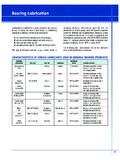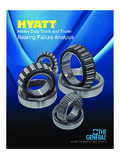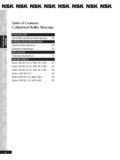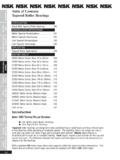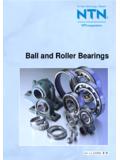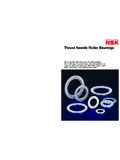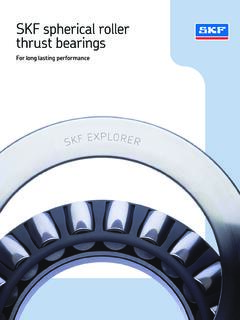Transcription of Measurement Accuracy Considerations for …
1 Ta p e r e d roller bearings, with their two part construction consisting of an outer race called a cup and inner race and rollers known as a cone assembly, lend themselves towards solving difficult assembly problems where high load carrying bearings are required. Cups and cone assemblies are separable and can be installed in the end assembly at different independent operations. The tapered roller bearing s ability to support both axial and radial loads is also a key feature to its selection in critical assemblies that support the unique loads generated by helical gearing such as used in transmissions and other power transfer products.
2 Two tapered roller bearings are often used and mounted in a cup back-to-back arrangement, sometimes referred to as an indirect mounting arrangement. (Figure 1) Designers of gearing systems often will seek arrangements that can offer little to no movement or play of the components mounted on the shaft attached to the gear. tapered roller bearings, if assembly is properly controlled, are ideally suited to these applications. GENERAL bearing CORPORATION An ISO/TS 16949 Certified Company Measurement Accuracy Considerations for tapered roller BearingsFig.
3 1 Indirect MountingMeasurement Accuracy Considerations for tapered roller Bearings The ideal range of settings for preload/endplay can be determined by interpreting a curve similar to Figure 2. tapered roller bearing preload, properly controlled, can actually enhance the life of the bearing system as shown on the curve. To o m u c h p r e l o a d a n d t h e l i f e w i l l drastically diminish and parasitic energy losses will increase. Determining the exact setting needed is the key to a high performance system where both long life for reliability, low system parasitic energy loss, and no play are required.
4 GENERAL bearing CORPORATION An ISO/TS 16949 Certified Company Fig. 2 Life v. Preload/EndplayMeasurement Accuracy Considerations for tapered roller Bearings Case Study Figure 3 shows an application of indirect mounting of tapered roller bearings. The drawing shows two tapered roller bearings. The lower bearing has its cone assembly mounted to a vertical shaft. The lower cup and upper cup are mounted to a fixed housing. The upper cone is press fitted to a hub on the bottom of a gear.
5 A selected spacer is installed between the face of the shaft and the face of the gear hub. The spacer is selected to impart a slight preload to both upper and lower tapered roller bearings. A nut installed at the end of the shaft is torqued to a constant value for all assemblies. Of utmost importance for both efficient assembly of the shaft and gear arrangement and long bearing life of the tapered roller bearings is the accurate sizing of the spacer used between the two contact faces. If the spacer is too small the axial preload on the two tapered roller bearings will be excessive and the torque to turn the two bearing will be very high.
6 If the spacer is too large, the shaft will have too much play which may lead to noise issues in the assembly and as our life v. endplay curve illustrates, shorter life for the bearings if the endplay is excessive. The issue then reduces down to the best way to accurately gauge the space between the two faces of the shaft and gear hub in the shaft-gear assembly so that the spacer is selected correctly every time. Since the cup and cone assembly of the upper bearing are separable they are installed on their respective components at different times and assembly stations.
7 As the two assemblies are separate prior to the spacer being installed there is an opportunity to measure the distance from the shaft face to a reference point on the upper cup. Similarly, the distance from the gear hub face to a reference point on the cone assembly can also be obtained. Measurement of the cone assembly reference point to gear hub face The gear and its installed cone assembly can be presented for Measurement with the cone assembly small end facing up. This provides the advantage of allowing gravity to assist in seating the large end of the rollers against the flange rib of the cone ring, which is its intended running position under load.
8 A good method to then obtain the distance from the hub face to the cone assembly reference point is to use a cup which has its inside contact portion in the geometric GENERAL bearing CORPORATION An ISO/TS 16949 Certified Company Fig. 3 Case Study applicationMeasurement Accuracy Considerations for tapered roller Bearings shape of a conical section. By using known masters the gear hub face to cone assembly reference point distance can be obtained reliably and accurately. Spinning of the cone assembly in the gauge cup will further increase Accuracy ensuring the rollers are properly seated after only a few turns.
9 Measurement of the shaft face to cup reference point Intuitively, it might be concluded that the best way to measure the shaft face to cup reference point would be to use a cone assembly. Unfortunately this would not work in practice as the rollers and cage are free to move vertically, restricted only by the rib located at the small end of the cone. Upon contact with a cup, some of the rollers would move up, but seating would not be guaranteed. Rotation of the cone assembly would eventually seat the rollers, however time to do this reliably would hinder assembly efficiency.
10 Adding the rotation feature would also make the gauge unnecessarily complex. The simplest method would be to use a fixed, solid gauge head that would simulate the interaction of a cone assembly with properly seated rollers. Again, one would probably assume the best shape to use would be a conical section. The conical section would be able to enter the cup, seat against the inside and allow the proper Measurement of the shaft face to cup reference point. Unfortunately, this also would not work, but not for obvious reasons.
